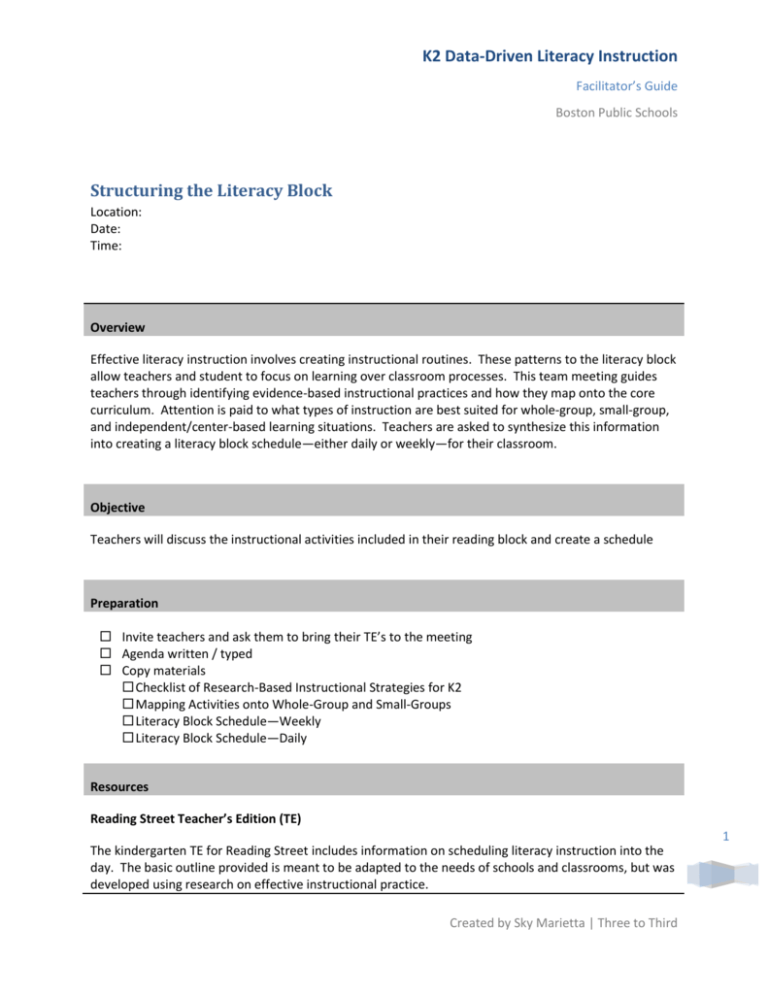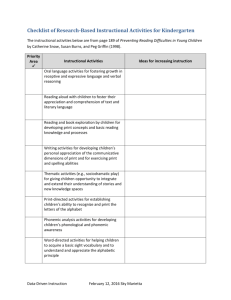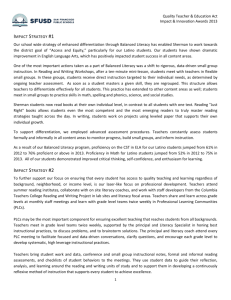K2 Data-Driven Literacy Instruction
advertisement

K2 Data-Driven Literacy Instruction Facilitator’s Guide Boston Public Schools Structuring the Literacy Block Location: Date: Time: Overview Effective literacy instruction involves creating instructional routines. These patterns to the literacy block allow teachers and student to focus on learning over classroom processes. This team meeting guides teachers through identifying evidence-based instructional practices and how they map onto the core curriculum. Attention is paid to what types of instruction are best suited for whole-group, small-group, and independent/center-based learning situations. Teachers are asked to synthesize this information into creating a literacy block schedule—either daily or weekly—for their classroom. Objective Teachers will discuss the instructional activities included in their reading block and create a schedule Preparation Invite teachers and ask them to bring their TE’s to the meeting Agenda written / typed Copy materials Checklist of Research-Based Instructional Strategies for K2 Mapping Activities onto Whole-Group and Small-Groups Literacy Block Schedule—Weekly Literacy Block Schedule—Daily Resources Reading Street Teacher’s Edition (TE) 1 The kindergarten TE for Reading Street includes information on scheduling literacy instruction into the day. The basic outline provided is meant to be adapted to the needs of schools and classrooms, but was developed using research on effective instructional practice. Created by Sky Marietta | Three to Third K2 Data-Driven Literacy Instruction Facilitator’s Guide Boston Public Schools Focusing on Special Populations: Like any other student, Ell’s benefit from direct instruction and guided practice in the context of familiar classroom structures. Developing a consistent classroom schedule will help Ell’s understand the expectations of the classroom and join instructional activities. 2 Created by Sky Marietta | Three to Third K2 Data-Driven Literacy Instruction Facilitator’s Guide Boston Public Schools Team Meeting Activities Key: = quick discussion/overview; = discussion item; = involved discussion Make sure that participants have with them the Reading Street Teacher’s Edition. 1. 2. Evidence-Based K2 Instructional Strategies a. Begin the session with a discussion of the structure of the Reading Street curriculum. What are the main components? What does a typical reading block look like in the program? b. Pass out copies of the “Checklist of Research-Based Instructional Activities for K2.” Ask teachers to think of how these proven strategies align with Reading Street and fit into the instructional day. Whole-Group, Small-Group, and Center-Based Learning a. 3. Creating a Schedule a. 4. Discuss what components of Reading Street are delivered through whole-group, small-group and centers/workstations. Pass out copies of the “Mapping Instruction to Whole- and Small-Groups.” What daily instructional routines will take place in circle time? In small groups? In centers/workstations? Using the TE’s as a framework, ask teachers to create their own literacy block schedule. You can pass out the daily or weekly version of the literacy block schedule depending on the needs of your school. Closing and reflection a. As the session ends, ask teachers to share one thing they will do new or differently this year in their reading block. 3 Created by Sky Marietta | Three to Third K2 Data-Driven Literacy Instruction Facilitator’s Guide Boston Public Schools Furthering the Conversation The following optional activity is designed to involve teachers in looking more closely at instructional practice. Communities of Practice: Many teachers post a large schedule in their classroom. Often these schedules are visual and meant to help students understand what the expectations for their current activity as well as what comes next. Teachers can, for example, paste a red arrow to a clothespin and move the clothespin up and down the schedule to show students the sequence of the day. Teachers may get together to make a classroom schedule specifically to display for students. 4 Created by Sky Marietta | Three to Third K2 Data-Driven Literacy Instruction Teacher Handout Checklist of Research-Based Instructional Activities for Kindergarten The instructional activities below are from page 189 of Preventing Reading Difficulties in Young Children by Catherine Snow, Susan Burns, and Peg Griffin (1998). Instructional Activities Oral language activities for fostering growth in receptive and expressive language and verbal reasoning Reading aloud with children to foster their appreciation and comprehension of text and literary language Reading and book exploration by children for developing print concepts and basic reading knowledge and processes Writing activities for developing children’s personal appreciation of the communicative dimensions of print and for exercising print and spelling abilities Thematic activities (e.g., sociodramatic play) for giving children opportunity to integrate and extend their understanding of stories and new knowledge spaces Print-directed activities for establishing children’s ability to recognize and print the letters of the alphabet Phonemic analysis activities for developing children’s phonological and phonemic awareness Word-directed activities for helping children to acquire a basic sight vocabulary and to understand and appreciate the alphabetic principle Created by Sky Marietta Three to Third What this looks like with Reading Street: K2 Data-Driven Literacy Instruction Teacher Handout Mapping Activities onto Whole- and Small-Groups Ask Yourself: What types of lessons or activities will be conducted in a whole- versus a small-group setting? How will work stations or centers reinforce instruction? Created by Sky Marietta Three to Third K2 Data-Driven Literacy Instruction Teacher Handout Literacy Block Schedule—Weekly Activity Time Period Created by Sky Marietta Three to Third Monday Tuesday Wednesday Thursday Friday K2 Data-Driven Literacy Instruction Teacher Handout Literacy Block Schedule—Daily Time Period Activity Created by Sky Marietta Three to Third








